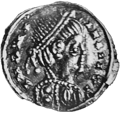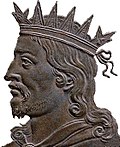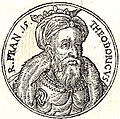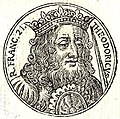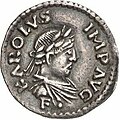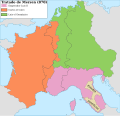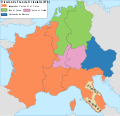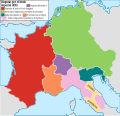Top Qs
Timeline
Chat
Perspective
List of Frankish kings
Frankish monarchs From Wikipedia, the free encyclopedia
Remove ads
The Franks, Germanic peoples that invaded the Western Roman Empire in the 5th century, were first led by individuals called dukes and reguli. The earliest group of Franks that rose to prominence was the Salian Merovingians, who conquered most of Roman Gaul, as well as the Gaulish territory of the Visigothic Kingdom, following the Battle of Vouillé in 507 AD.
This article has multiple issues. Please help improve it or discuss these issues on the talk page. (Learn how and when to remove these messages)
|


The sons of Clovis I, the first King of the Franks, conquered the Burgundian and the Alamanni Kingdoms. They acquired Provence, and went on to make the peoples of the Bavarii and Thuringii their clients. The Merovingians were later replaced by the new Carolingian dynasty in the 8th century. By the late 10th century, the Carolingians themselves had been replaced throughout much of their realm by other dynasties.
A timeline of Frankish rulers has been difficult to trace since the realm, according to old Germanic practice, was frequently divided among the sons of a king upon the king's death. However, territories were eventually reunited through marriage, treaty or conquest. There were often multiple Frankish kings who ruled different territories, and divisions of the territories were not very consistent over time.
As inheritance traditions changed over time, the divisions of Francia (the lands of the Franks) started to become kingdoms that were more permanent. West Francia formed the heart of what was to become the Kingdom of France; East Francia evolved into the Kingdom of Germany; and Middle Francia became the Kingdom of Lotharingia in the north, the Kingdom of Italy in the south, and the Kingdom of Provence in the west. West and East Francia soon divided up the area of Middle Francia.
The idea of a "King of the Franks" (Rex Francorum) gradually disappeared. The title "King of the Franks" is attested in the Kingdom of France until 1190, that of "Queen of the Franks" (for queen consorts) until 1227. That represented a shift in thinking about the monarchy from that of a popular monarchy, the leader of a people, sometimes without a defined territory to rule, to that of a monarchy tied to a specific territory.
Remove ads
Early Frankish rulers
Orthouad (1st century?)
- Genobaud (3rd century?)
- Merogais and Ascaric (4th century)
- Marcomer (4th century), dux
- Sunno (4th century), dux
- Genobaud (4th century), dux
- Mallobaudes (4th century)
- Theodemer (5th century)
- Ragnachar (died c. 509), killed by Clovis
- Chararic (died c. 509), killed by Clovis
Salian Franks
- Chlodio (5th century, reputedly son of legendary Pharamond)
- Merovech (c. 450–457), perhaps a son of Chlodio
- Childeric I (c. 457–481), son of Merovech
- Clovis I (c. 481–511), the first Merovingian king, who united all Franks by 509
Ripuarian Franks
- Childebert (5th century)
- Sigobert the Lame (died c. 509), killed at the instigation of Clovis
- Chlodoric the Parricide (died c. 509), son of Sigobert, killed by Clovis
Remove ads
Merovingian dynasty
Summarize
Perspective
Early Kings of the Franks (509–613)
Clovis I united all the Frankish petty kingdoms as well as most of Roman Gaul under his rule, conquering the Domain of Soissons of the Roman general Syagrius as well as the Visigothic Kingdom of Toulouse (Aquitaine). He took his seat at Paris, which along with Soissons, Reims, Metz, and Orléans became the chief residences. Upon his death, his four sons – and later his grandsons – split the kingdom among them. Every son received a part of the original Frankish territory and also a part of the newly acquired Aquitaine.[1]
- Lines of Theuderic I and Sigibert I (Kings at Reims/Metz (Austrasia) and later in Burgundy)
- Chlodomer and Guntram (Kings at Orleans and Burgundy)
- Childebert I and Charibert I (Kings at Paris)
- Lines of Clothar I and Chilperic I (Kings at Soissons)
Kings in Neustria and Burgundy (613–679)
Chlothar II defeated Brunhilda and her great-grandson, Sigibert II, reunifying the kingdom. By that time the realms of Neustria, Burgundy and Austrasia had developed regional identities. In order to appease the local nobility, Austrasia was usually ruled by separate king, often a son or brother of the king ruling in Neustria and Burgundy. A similar arrangement for Aquitaine was short-lived.
Kings in Austrasia (623–679)
Chlothar II had reunified the kingdom in 613. By that time the realms of Neustria, Burgundy and Austrasia had developed regional identities. In order to appease the local nobility, Clothar made his young son, Dagobert I, king of Austrasia. Austrasia was usually ruled by a separate king, often a son or brother of the king ruling in Neustria and Burgundy, for the following decades.
Later Kings of the Franks (679–751)
Theuderic III was recognized as king of all the Franks in 679. From then on, the kingdom of the Franks can be treated as a unit again for all but a very brief period of civil war. This is the period of the roi fainéant, "do-nothing kings" who were increasingly overshadowed by their mayors of the palace.
Remove ads
Carolingian dynasty
Summarize
Perspective
The Carolingians were initially mayors of the palace under the Merovingian kings, first in Austrasia and later in Neustria and Burgundy. In 687 Pepin of Heristal took the title Duke and Prince of the Franks (dux et princeps Francorum) after his conquest of Neustria in at the Battle of Tertry, which was cited by contemporary chroniclers as the beginning of Pepin's reign. Between 715 and 716, the descendants of Pepin disputed the succession.
Finally, in 747 Pepin the Short became Mayor of the Palace of Austrasia in addition to that of Neustria, making him ruler of the entire Frankish kingdom. He arranged for the deposition of the Merovingian king Childeric III and in March 752,[6][7] Pepin was himself anointed King of the Franks. The office of Mayor was absorbed into the Crown, and this marked the start of the Carolingians as the ruling dynasty. Charlemagne was crowned emperor in the year 800, beginning the line of Holy Roman Emperors that lasted (with some interruptions) until 1806, although the title was held by German monarchs after 962.
Louis the Pious made many divisions of his empire during his lifetime. The final division, pronounced at Worms in 838, made Charles the Bald heir to the west, including Aquitaine, and Lothair heir to the east, including Italy and excluding Bavaria, which was left for Louis the German. However, following the emperor's death in 840, the empire was plunged into a civil war that lasted three years. The Frankish kingdom was then divided by the Treaty of Verdun in 843. Lothair was allowed to keep his imperial title and his kingdom of Italy, and granted the newly created Kingdom of Middle Francia, a corridor of land stretching from Italy to the North Sea, and including the Low Countries, the Rhineland (including Aachen), Burgundy, and Provence. Charles was confirmed in Aquitaine, where Pepin I's son Pepin II was opposing him, and granted West Francia (modern France), the lands west of Lothair's Kingdom. Louis the German was confirmed in Bavaria and granted East Francia (modern Germany), the lands east of Lothair's kingdom.
The following table does not provide a complete listing for some of the various regna of the empire, especially those who were subregna of the Western, Middle, or Eastern kingdom such as Italy, Provence, Neustria, and Aquitaine.
Remove ads
Kings of all Franks (simplified)
- Clovis I (c. 509–511)
- Chlothar I (558–561)
- Dagobert I (632–634)
- Chlothar III (662–663)
- Childeric II (673–675)
- Theuderic III (679–691)
- Clovis IV (691–695)
- Childebert IV (695–711)
- Dagobert III (711–715)
- Chilperic II (715–717, 719–721)
- Theuderic IV (721–737)
- Charles Martel (regent, 737–741)
- Childeric III (743–751)
- Pepin the Short (751–768)
- Charles the Great (771–814)
- Louis the Pious (814–840)
- Charles the Fat (885–887)
Remove ads
Graphic lists
Summarize
Perspective
Successors of Clovis I (511–561)
| Soissons | Orléans | Paris | Austrasia | |
| 509–511 | Clovis I (king of all Franks) | |||
| 511–524 | Chlothar I (Soissons, 511–561) (sole king, 558-561) |
Chlodomer (Orleans, 511–524) |
Childebert I (Paris, 511–558) |
Theuderic I (Austrasia, 511–534) |
| 524–532 | ||||
| 532–534 | ||||
| 534–548 | Theudebert I (Austrasia, 534–548) | |||
| 548–555 | Theudebald (Austrasia, 548–555) | |||
| 555–558 | ||||
| 558–561 | ||||
Successors of Chlothar I (561–634)
Successors of Dagobert I (634–751)
| Neustria & Burgundy | Austrasia | |
| 634–639 | Dagobert I (former king of all Franks, 632-634) (king of Neustria, 629–639) |
Sigebert III (king of Austrasia, 634–656) Mayor of the palace: Adalgisel; Pepin I; Otto; Grimoald I |
| 639–656 | Clovis II (639–657) Mayors: Aega; Erchinoald in Neustria; Flaochad; Radobertus in Burgundy | |
| 656–657 | Childebert III the Adopted (656–662) Mayor of the palace: Grimoald I | |
| 657–658 | Chlothar III (657–673) Mayor of the palace: Ebroin | |
| 658–662 | ||
| 662–663 | ||
| 663–673 | Childeric II (663–675) Mayor of the palace: Wulfoald | |
| 673 | Theuderic III Mayor of the palace: Ebroin | |
| 673–675 | ||
| 675–676 | Theuderic III (restored) Mayors: Leudesius (675); Ebroin (675–680); Waratton (681); Gistemar (682); Waratton (682–685); Berchar (686); Nordebert (687–695) |
Clovis III Mayor of the palace: Wulfoald |
| 676–679 | Dagobert II Mayor of the palace: Wulfoald | |
| 679–691 | (king of all Franks; 679–691) | Mayor of the palace: Pepin II (680–714) |
| 691–695 | Clovis IV (691-695) | |
| Mayor: Nordebert | Mayor: Pepin II | |
| 695–711 | Childebert IV (695-711) | |
| Mayors: Grimoald II in Neustria; Drogo in Burgundy | Mayor: Pepin II | |
| 711–715 | Dagobert III (711-715) | |
| Mayors: Grimoald II (695–714); Theudoald (714–715) | Mayor: Pepin II (679–714); Theudoald (714–-716) | |
| 715–717 | Chilperic II (715-721) | |
| Mayor: Ragenfrid (715–719) | Mayor: Theudoald (714–716) | |
| 717–719 | Chlothar IV (rival king in Austrasia, 717–719) Mayor: Charles Martel (717–741) | |
| 719–721 | Mayor: Charles Martel (719–741) | |
| 721–737 | Theuderic IV (721-737) Mayor: Charles Martel (719–741) | |
| 737–743 | Interregnum Mayor: Charles Martel (719–741) | |
| Mayor: Pepin the Short (741–751) | Mayor: Carloman (741–747) | |
| 743–751 | Childeric III (743-751) | |
| Mayor: Pepin the Short (741–751) | Mayor: Carloman (741–747) | |
Successors of Louis I (840–987)
Remove ads
See also
References
Sources
Further reading
External links
Wikiwand - on
Seamless Wikipedia browsing. On steroids.
Remove ads





